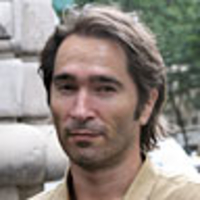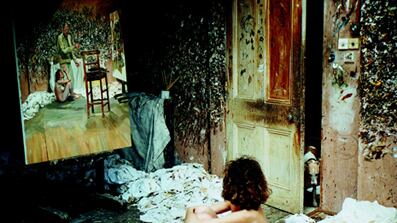In our overexposed era when the most intimate details of life are impulsively posted on confessional blogs and in social-networking status updates, or blurted out on reality television, authentic intimacy is strikingly powerful—and valuable.
That thought came to mind as I took in Lucian Freud—The Studio, a just-opened retrospective of the 88-year-old English painter’s work at the Pompidou Centre of Modern Art in Paris. The exhibit, which consists of approximately four-dozen of Freud’s flesh-filled works, includes multimillion-dollar paintings from private collections that the public can rarely admire. The retrospective, which runs until July 19 and spans Freud’s lengthy career, conveys the depth of the refreshing intimacy that soaks his work with a ironic authenticity that can be alternately captivating and difficult to absorb in a world where people go further than ever to make representations of themselves appear “perfect.”
Click Image to View Our Gallery of Lucian Freud—The Studio

Cécile Debray, the Pompidou Centre curator who selected the pieces for the exhibit, described Freud’s work to The Daily Beast as a “modest realism” that can tend toward cruelty. That cruelty to his subjects is abundantly clear in the craggy recesses, viscous veins, towering mounds of floppy fat, and blemished genitalia, sometimes placed front and center in enormous paintings. It is art that reaches deep into arteries and jowels that sag with life lived. In such a context, “modesty” is largely limited to Freud’s “relationship to the reality” that he paints, as Debray clarifies.
The contradictions of such "explicit modesty" makes ironic sense in a world where his 1995 nude, of a 280-pound civil servant named Sue Tilley napping on a sofa, sold at Christie's in New York for $33.6 million in 2008 under the title, Benefits Supervisor Sleeping—making Freud the most-expensive living painter on the planet.
(Freud’s vision has even allowed him to harvest humanity from an icon of the world of fashion and advertising, supermodel Kate Moss, whom he paints as a compelling and strikingly normal-looking woman; imperfect, askew, awkward, uneven, during her pregnancy. That painting is not a part of the Paris exhibit, but it fetched $10 million in 2004.)
The Pompidou’s exhibit also brings together most of Freud’s Large Interiors, a number of often-nude self-portraits, his variations on the Old Masters, and several prints and drawings. But it is dominated by the works from his apogee in the 1990s and 2000s, especially the outsized majestic masterpieces, including the dramatic portraits of the extravagant performing artist Leigh Bowery—particularly 1994’s Leigh under the Skylight—and, of course, “Big Sue.”
Freud has said that he labors to document his immediate surroundings, and the final section of the four-gallery exhibit includes two short films and a number of photos of the artist and his studio environment. In that sheltered workspace, he creates backgrounds in which his friends and longtime acquaintances pose before worn-out furniture, discarded clothing, sloppy dabs of paint on walls and the floor, as well as building interior material, such as a sink or pipes, most of which he makes seem oddly personal. He then immerses himself in that closed-off environment for months or even years, and very gradually shapes the painting with little or no planning, and similarly little reference to previous works. “The construction of a painting is an adventure in which he is totally absorbed,” explains the curator. And once the painting is complete, she explains, he largely sees it as a failure before he “moves on to the next one.”
Despite that, Debray says that Freud seemed to be “very touched” when he saw the Pompidou exhibit’s vision brought together. This makes sense given that Freud lives intensely with a painting while he is creating it, but he works on the next oeuvre in a studio that is devoid of art. This means that he tends to only see older paintings or the arc of his career at such showings.
Born in Germany before his parents migrated to Britain, Freud is, of course, the grandson of Sigmund Freud, the father of modern psychoanalysis. Both men offered (and continue to offer) their contemporaries new insights into themselves and the immediate world around them. Just as Sigmund was unrivaled in his domain, few if any living portraitists are in Lucian’s league. And as with his grandfather, it isn’t always easy to digest the truths that Lucian shows us about ourselves, but his obsessive honesty about the humanity that he portrays offers a seemingly priceless perspective on our human condition.
Perhaps that is what Lucian Freud meant when he said, “I want paint to work as flesh.” Left unsaid is that the flesh that he is interested in is weak.
Plus: Check out Art Beast, for galleries, interviews with artists, and photos from the hottest parties.
Eric Pape has reported on Europe and the Mediterranean region for Newsweek Magazine since 2003. He is co-author of the graphic novel Shake Girl, which was inspired by one of his articles. He is based in Paris. Follow him at twitter.com/ericpape





